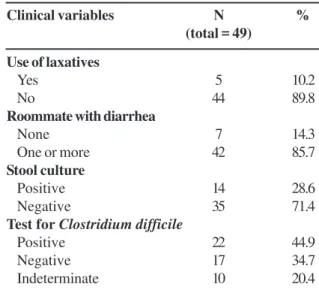Nosocomial diarrhea in the intensive care unit
Texto
Imagem


Documentos relacionados
(2003) “Nosocomial infections in medical -surgical intensive care units in Argentina: Attributable mortality and length of stay” American Journal of Infection Control. Stone
The clinical outcome of the elderly who acquire an infec- tion in the intensive care unit is influenced by sociodemo- graphic (age, length of stay, presence of preexisting
Risk factors of delayed extubation, prolonged length of stay in the intensive care unit, and mortality in patients undergoing coronary artery bypass graft with fast-track
Thus, this study aims to describe the withdrawal of bed frequency in invasive MV ICU patients, and its reflexes on mortality and length of stay in the intensive care
In summary, in our cohort of oncohematological patients discharged alive from the intensive care unit, male sex, emergency surgery, longer length of stay before intensive care
Transmission-associated nosocomial infections: prolongations of intensive care unit stay and risk factor analysis using multistate models. Hospital- and
Ventilator-associated pneumonia (VAP) remains one of the major causes of infection in the intensive care unit (ICU) and is as- sociated with the length of hospital stay, duration
The aim of this study is to evaluate the functional capacity and length of stay of patients in a nosocomial intensive care unit who underwent prophylactic non-invasive ventilation